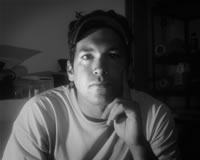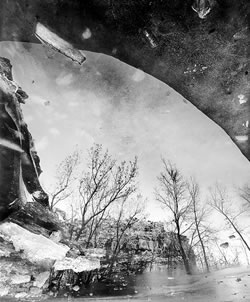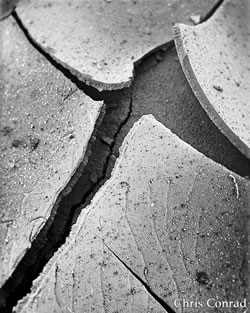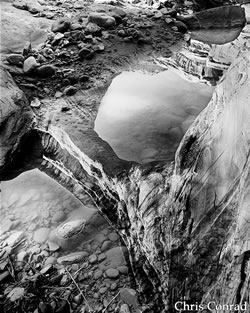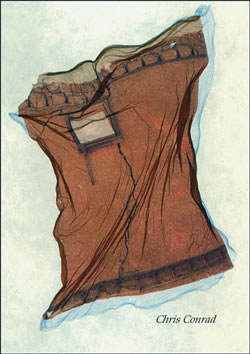Artist of the Month - March 2007 Chris Conrad
Captures the Ephemeral |
|||||
Photography is a paradoxical technology.
It is an efficient method to document ephemeral moments-a
family vacation, a child’s birthday. Those of us
who use photography for this means value its veracity at
reflecting exactly what the eye perceives through the lens
of the camera. We also value the fact that a successful
photo can be reproduced over and over again, allowing us
to send the same image to relatives, friends and anyone
in between.
He now uses various equipment and materials
to create his original images, including Polaroid, medium
format and 4x5 negatives. He soon craved a way of making his images distinctive, personal and unique. One element that Conrad admires about other visual arts is how they are inherently one-of-a-kind. For example, a painter can paint the same subject matter a number of times, but each painting is unique.
This desire to express his individual
artistic vision through the lens of a camera led Conrad to
explore black-and-white photography. He explains that he
finds it, “more abstract, and therefore, more artistic
because there is so much latitude in exposure, which allows
the photographer to read the tones of a scene.” Since
he develops his own film, he finds freedom to alter the image
further in that process. The first photograph in the book is entitled “Cracked Mud,” and depicts a highly detailed close-up of the fissured, curled dried earth, representing the desert at its most arid. The progression of the photos depicts the landscape through reflections in puddles and streams, whose existence depends on fleeting rain and snow falls.
These landscape photos evoke a poignant mood by portraying pristine areas void of human traces and by using a complete range of shading from bright white to obsidian. In many of the images, the subject matter is abstracted, making it difficult to recognize what has been captured outright and what is being reflected in water. “Sipapu Bridge Reflection” is
a good example of how Conrad uses this abstraction effectively.
The waterline in the photo is almost impossible to discern
without his help, making it difficult to recognize that the
image of the bridge is actually a reflection in the stream.
A closer inspection of the photo reveals the river pebbles
underneath the reflection of the rock formation.
He continues to achieve this ethereal effect with his current photography, in which he explores various ways of creating abstract images. For the recent annual art exhibit, “Moab Abstracts,” Conrad contributed several works, including “Sego Polaroid.” From afar, the image looks like a piece of dark lace gathered and glued to the page, belying the durability of the actual subject of the photo, a wall. He took the picture with a Polaroid, then distressed the photo by boiling it and separating the top layer of film. Conrad is pushing the boundaries of photography by working in the third dimension with his images and, at the same time, producing a unique piece that cannot be duplicated simply by subsequent prints. Conrad feels privileged to have entered
this field when it was at such a crossroads in its development.
Although he appreciates the new horizons digital photography
opens, he prefers the traditional technologies. This ability
to straddle two paths and appreciate what each may have to
offer is a quality that Conrad exhibits in many areas of
his life, particularly as he is part of the crossroads Moab
has reached in its development as a community. |
